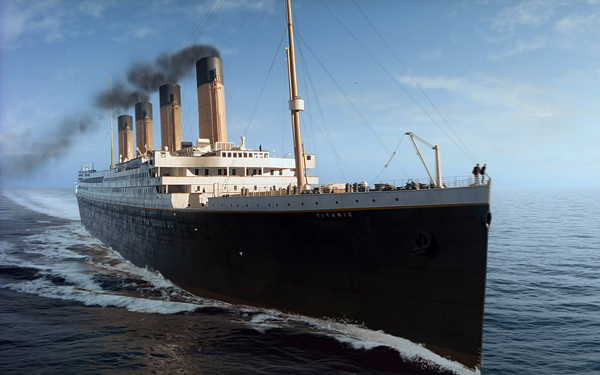William Murdoch came from a family of sailors. Known as a hard worker, he rose through the ranks of the White Star Line, and was the First Officer of the R.M.S. Titanic. On the night of the 14th April, 1912, he was the officer on duty when the ship struck an iceberg.

William Murdoch prior to Titanic’s voyage (author’s collection)
Upon being informed that the ship was mortally wounded he spent the next two hours and forty minutes helping passengers into lifeboats and evacuating them as quickly and safely possible. Knowing there were more people than boats, he allowed men to board the lifeboats if there were spaces still open before they left, and is credited with saving a number of people as a result of that decision.
As the remaining boats left the Titanic he shook hands with a good friend and fellow crew member, saying “Goodbye and good luck”.
In the final moments of the sinking Murdoch was last seen working with a group of crew members trying to cut the last emergency lifeboat loose, when the waters washed over the forward section. William Murdoch was 39 when he became one of the 1500 lives lost in the world’s worst peacetime disaster. His grief stricken family created a memorial scholarship for his heroic sacrifice in his hometown of Dalbeattie, Scotland.
In James Cameron’s film Titanic, William Murdoch was seen on screen accepting bribes from the fictional character Cal Hockley, before shooting himself in the final moments of the film.
As a result, donations to Murdoch’s scholarship soon dwindled to virtually nothing, as the film’s version of events became accepted as the truth. The town of Dalbeattie and the remaining Murdoch family members wrote to 20th Century Fox requesting an apology. In response, the vice-president for 20th Century Fox travelled to Dalbeattie, and handed over a check as compensation for the distress caused.
The scholarship still runs today, allowing students to better their education.
Bruce Ismay was the Managing Director of the White Star Line, and the son of its founder Thomas Henry.

Bruce Ismay (author’s collection)
The British Board of Trade Regulations stated that all ships were to carry 16 lifeboats total. Ismay designed the ship to carry 20.
He attended the maiden voyage and spent time among the passengers. When Titanic struck the iceberg Ismay was asleep in his cabin, but woke after noticing the engines had stopped. Once it was confirmed that the ship would sink he threw clothing over his pajamas, and assisted the crew with evacuating passengers.
In the last half hour he went towards collapsible lifeboat C where First Officer Murdoch was still allowing men to board, space permitting. Not seeing other passengers nearby he climbed on as the boat was lowering.
On his return he was vilified in the press, and later forced to resign from the White Star Line. He lived his remaining years as a recluse.
In James Cameron’s film Titanic, the character Bruce Ismay is portrayed as cold and arrogant, clearly based on the reports of him in the papers at the time. And relatives of Ismay still suffer from the lingering stigma. “I can’t tell you how many times I’ve been asked by people if I’m related to the Coward of the Titanic,” said Cliff Ismay, fifth cousin to Bruce.

Jonathan Hyde as Bruce Ismay in Titanic © 1997 – Paramount Pictures
Films based on real-life events frequently take liberties with the facts. This is done for a number of reasons, and generally justified as being necessary to meet the demands of plot or storytelling, or to better tell an ‘emotional’ truth. But too often, this is done without thought for the consequences.
Filmmakers may argue that they are presenting a film ‘based’ on real events, not a historical documentary. But too often, viewers do not make that distinction. Rightly or wrongly, the version of events we see on screen is the version that we accept as fact. And indeed, the power of cinema to make us believe in the characters and situations it presents, to care about and remember them, only serves to engrain a film’s version of events in our memories and our hearts.

RMS Titanic departing Southampton on April 10, 1912. Credit: F.G.O. Stuart
But leaving aside the question of whether, as a writer, one has a duty to the historical facts, let’s look at whether it was even necessary to do so in the case of the Titanic.
From a writing perspective, the story of the Titanic provides 2,208 characters to choose from. Among these are plenty whose stories could surely provide sufficient drama and ‘emotional truth’ without straying from the facts.
For example, consider the story of passenger Edith Russell (Rosenbaum), one of the first fashion consultants, and a correspondent to Women’s-Wear Daily. She was sailing on Titanic with an entire collection that was to be introduced to New York society.
Her father had given her a toy musical pig when she was young, and told her it would bring good luck to her life. She carried this with her on the voyage. When the ship began sinking Edith boarded one of the lifeboats, but soon realized her “lucky pig” was still inside the cabin. So she climbed out and raced through the corridors to retrieve it, and then locked all the storage lockers holding the wardrobe collection because she didn’t trust the crew with it.
Russell then boarded lifeboat 11 with her beloved toy. During the course of the sinking and its aftermath, she used it to help soothe the frightened children in the lifeboat until they were rescued.
In her story, surely we have everything and more required to build a script around. And in the pig we even have a symbol and focal point reminiscent of Rosebud from Citizen Kane.
In fact, the story of Edith Russell’s pig was included in the screenplay for the film A Night to Remember. For that film, Ms. Russell not only granted the writers an interview for them to work from, but also helped the production crew by signing on as the costume consultant.
And so we see another advantage of sticking more closely to historical facts – by gaining the approval of the real-life people involved, one can gain unique insights and unexpected help.

Edith Russell showing her pig to Teresa Thorne, who played Russell in the film A Night to Remember (author’s collection)
So when conducting research, go beyond Google and Wikipedia. Don’t be afraid to get your hands dirty in libraries and town archives. Seek out expert sources such as historians and journalists. If possible, don’t just accept one version of facts – seek out and study conflicting versions. Then ask yourself why they differ.
And most importantly, where possible try to make contact with people who can offer first-hand perspectives on the events, either those people you are writing about, or their relatives and descendents. By doing so you can not only uncover information which may not available elsewhere, but as the writers of A Night to Remember discovered, the possibility of obtaining further support and help with your project.

Thomas Andrews as Michael Goodliffe and Robbie Lucas as John Merivale in A Night to Remember (1958)
Real life events are a fantastic source of inspiration for storytelling. And from a visual perspective, James Cameron’s telling of the sinking of Titanic is a remarkable success, as he conveyed the beauty and the tragedy of the voyage. However, by blurring the lines between fact and fiction he inadvertently caused a great deal of harm.
As a screenwriter, the way you present a story on screen will (hopefully) be remembered. It is important. So when writing a fact-based or biographic film, ask yourselves this: how would you want your life story told?
Featured image: Titanic © 1997 – Paramount Pictures
[addtoany]

